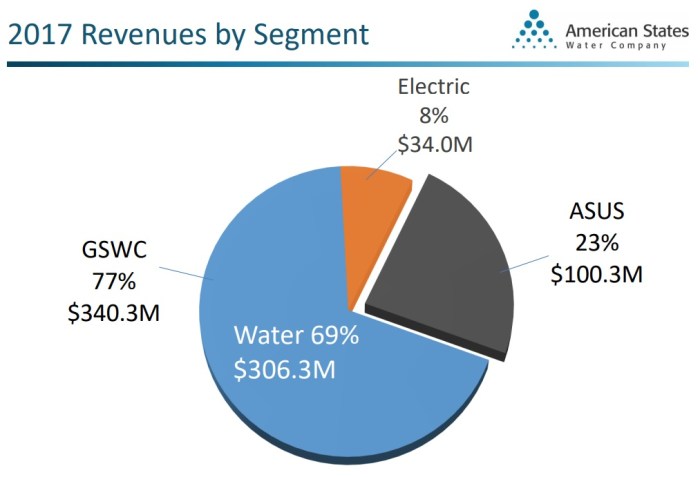Understanding the American States Water Stock Market
American states water stock price – The American water sector presents a unique investment landscape, influenced by a complex interplay of factors. Understanding these dynamics is crucial for navigating this market effectively. Stock prices in this sector are not solely determined by traditional financial metrics; they are significantly impacted by environmental conditions, regulatory changes, and technological advancements.
Factors Influencing Water Stock Prices
Several key factors influence the stock prices of companies involved in American states’ water resources. These include the level of water scarcity in different regions, the stringency of environmental regulations, the overall financial health of the companies, and the adoption of innovative technologies within the sector. Increased water scarcity, for instance, can drive up demand for water management services and lead to higher stock prices for companies providing these services.
Conversely, relaxed regulations might reduce the operational costs of water companies, positively affecting their profitability and stock value.
Water Scarcity, Regulations, and Stock Performance

Source: shutterstock.com
A strong correlation exists between water scarcity, regulatory changes, and the performance of water-related stocks. Prolonged droughts or periods of extreme water stress can significantly impact the profitability of water utilities and related businesses, potentially leading to stock price declines. Conversely, stringent environmental regulations, while increasing operational costs, may also enhance a company’s reputation for sustainability, potentially attracting environmentally conscious investors and supporting higher stock valuations.
The implementation of new water conservation technologies can also influence stock prices, depending on the effectiveness and market adoption of such technologies.
Comparative Financial Performance of Major Players
Analyzing the financial performance of major players in the American water market provides valuable insights into the sector’s overall health and potential investment opportunities. Below is a comparative analysis of three hypothetical companies (actual company data would need to be sourced from reliable financial databases):
| Company Name | Stock Ticker | Market Cap (USD Billions) | Year-over-Year Growth (%) |
|---|---|---|---|
| AquaCorp | AQUA | 15 | 8 |
| HydroSolutions | HYDS | 12 | 5 |
| PureWater Inc. | PURE | 8 | 12 |
Investment Strategies in the American Water Sector: American States Water Stock Price
Investing in the American water sector requires a nuanced approach, considering both the opportunities and risks involved. Investment strategies should be tailored to individual risk tolerance levels, with a thorough understanding of the market’s dynamics.
Potential Investment Strategies
Conservative investors might favor established, large-cap water utilities with a history of stable dividends and consistent revenue streams. More aggressive investors could consider smaller companies focused on innovative technologies or those operating in regions experiencing significant water scarcity, acknowledging the higher risk associated with such investments. Diversification across different segments of the water sector (e.g., utilities, technology providers, water treatment companies) can also help mitigate risk.
Examples of Successful and Unsuccessful Investments
Successful investments often involve companies that effectively adapt to changing regulations, invest in innovative technologies, and maintain strong financial performance. Conversely, unsuccessful investments may be characterized by poor management, financial instability, or a failure to adapt to evolving environmental conditions or regulatory changes. For example, a company heavily reliant on outdated irrigation technologies might struggle in the face of increasing water scarcity and stricter regulations.
Long-Term Outlook for Water Resource Management Companies
The long-term outlook for investments in water resource management companies is generally positive, driven by factors such as projected population growth and the intensifying impacts of climate change. Increasing water scarcity and the growing demand for clean water are expected to fuel growth in this sector. However, investors should remain aware of potential challenges, including regulatory uncertainty and the need for ongoing innovation to meet evolving needs.
Regulatory Landscape and its Impact
The regulatory environment significantly shapes the water industry, impacting the stock prices of companies operating within this sector. Understanding the key regulatory bodies and their influence is essential for informed investment decisions.
Impact of State and Federal Regulations
State and federal regulations play a crucial role in determining the operational costs, investment requirements, and overall profitability of water companies. Stricter regulations, while promoting environmental sustainability, can increase compliance costs, potentially affecting short-term profitability. However, companies that successfully navigate these regulations and demonstrate environmental responsibility may attract investors concerned about environmental, social, and governance (ESG) factors.
Key Regulatory Bodies and Their Influence
Several key regulatory bodies influence the water sector at both the state and federal levels. The Environmental Protection Agency (EPA) at the federal level sets national standards for water quality and safety. Individual states also have their own regulatory agencies that oversee water resource management and allocation within their jurisdictions. The influence of these bodies can vary considerably across different states.
Regulatory Environments Across Different States
The regulatory environments across different American states can vary considerably, impacting the operations and stock prices of water companies. Some states may have stricter regulations regarding water usage and wastewater treatment, leading to higher compliance costs for companies operating within those jurisdictions. Other states might have more lenient regulations, potentially reducing operational costs but also potentially leading to greater environmental risks.
| State | Key Regulatory Body | Major Regulations | Impact on Stock Prices |
|---|---|---|---|
| California | State Water Resources Control Board | Stringent water usage restrictions, wastewater discharge permits | Potentially negative short-term impact due to increased compliance costs, but potentially positive long-term impact due to increased demand for water-saving technologies. |
| Texas | Texas Commission on Environmental Quality | Regulations on groundwater withdrawal, wastewater treatment | Variable impact depending on specific company operations and adaptation to regulations. |
| Florida | Florida Department of Environmental Protection | Regulations on water quality, coastal protection | Similar to Texas, variable impact depending on company operations and adaptation. |
Technological Advancements and Their Impact
Technological advancements are transforming the water sector, creating both opportunities and challenges for companies and investors. These innovations are improving efficiency, reducing costs, and enhancing sustainability.
Technological Innovations Affecting Water Stock Prices
Several technological innovations are significantly impacting the stock prices of water-related companies. Companies that successfully adopt and implement these technologies are likely to experience enhanced profitability and increased investor interest.
- Water Purification Technologies: Advanced membrane filtration, reverse osmosis, and other purification technologies are improving the efficiency and cost-effectiveness of water treatment, leading to increased profitability for companies utilizing these technologies.
- Smart Irrigation Systems: These systems optimize water usage in agriculture and landscaping, reducing water waste and improving efficiency. Companies providing these systems can experience increased demand and profitability.
- Water Leak Detection Systems: These systems help utilities identify and repair leaks, reducing water loss and improving operational efficiency. Companies providing these systems can benefit from increased demand.
- Remote Sensing and Monitoring: Technologies such as satellite imagery and sensor networks enable real-time monitoring of water resources, improving management and conservation efforts.
Environmental Concerns and Stock Performance
Environmental concerns, such as droughts and pollution, significantly influence the stock performance of water companies. Companies with robust sustainability practices tend to fare better during periods of environmental stress.
Influence of Environmental Concerns on Stock Prices

Source: googleusercontent.com
Severe droughts can lead to water shortages, impacting the operations of water utilities and related businesses. Pollution incidents can damage a company’s reputation and lead to costly cleanup efforts. Conversely, companies actively involved in sustainable water management practices may experience increased investor interest and higher stock valuations.
Companies with Sustainable Water Management Practices
Several companies are actively involved in sustainable water management practices, including water conservation, wastewater recycling, and the implementation of green technologies. These companies often attract investors concerned about ESG factors and may experience enhanced stock performance over the long term. For example, a company that invests heavily in water recycling infrastructure might experience increased demand for its services during a drought.
Hypothetical Scenario: Major Environmental Event Impact, American states water stock price
A hypothetical scenario: A major earthquake in California damages critical water infrastructure, causing widespread water shortages. This would likely lead to a significant short-term decline in the stock prices of water utilities operating in the affected region. However, companies that can quickly respond to the crisis and provide emergency water services might experience increased demand and potentially higher stock valuations in the long run.
Financial Analysis of Key Players
A thorough financial analysis of publicly traded water companies provides insights into their financial health and stability. Key financial ratios and metrics help assess their performance and risk profile.
Financial Analysis of Two Hypothetical Companies
The following table presents a hypothetical financial analysis of two publicly traded water companies. (Note: Actual financial data would need to be obtained from reliable sources.)
| Company Name | Revenue (USD Millions) | Net Income (USD Millions) | Debt-to-Equity Ratio |
|---|---|---|---|
| AquaCorp | 500 | 75 | 0.8 |
| HydroSolutions | 300 | 40 | 1.2 |
Comparison of Financial Health and Stability
AquaCorp demonstrates a stronger financial position compared to HydroSolutions, exhibiting higher revenue, net income, and a lower debt-to-equity ratio. A lower debt-to-equity ratio indicates lower financial risk. However, a more comprehensive analysis would require examining additional financial ratios and metrics, such as profitability margins, return on equity, and cash flow.
Key Financial Ratios and Metrics
Key financial ratios and metrics used to assess the performance of water companies include revenue growth, net income margins, return on equity, debt-to-equity ratio, and cash flow from operations. These metrics provide insights into profitability, financial stability, and overall performance.
Questions and Answers
What are the major risks associated with investing in American States Water stock?
Major risks include drought conditions impacting water availability, regulatory changes altering operational costs, and competition from other water providers. Furthermore, unexpected environmental events or shifts in public perception of water management practices could negatively impact stock prices.
How does climate change affect the water stock market?
Climate change intensifies water scarcity in some regions, increasing demand and potentially boosting the value of water resource management companies. However, it also presents risks through increased frequency and severity of extreme weather events which can disrupt operations and increase costs.
Are there any ethical considerations for investing in this sector?
Analyzing the American States Water stock price requires a multifaceted approach, considering factors like drought conditions and regulatory changes. It’s interesting to compare this to the performance of other publicly traded utilities; for instance, understanding the current aldis stock price can offer insights into broader market trends affecting similar companies. Ultimately, however, the American States Water stock price remains dependent on its own operational performance and the specific demands of its service areas.
Ethical considerations include the environmental impact of water extraction and distribution, fair pricing practices, and the company’s commitment to sustainable water management practices. Investors may wish to research a company’s ESG (Environmental, Social, and Governance) performance before investing.



